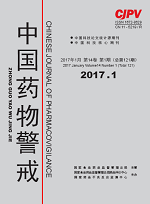|
|
Analysis of 281 Medication Errors of Antineoplastic Drugs
ZHU Chen, CUI Can, LI Xiao-ling, YAN Su-ying, WANG Yu-qin
2017, 14(1):
40-44.
ObjectiveTo understand the current status of medication error (ME) report of antineoplastic drug in China and improve the safety awareness of drug use. MethodsME cases reported from Sep. 22 nd, 2012 to Dec. 31st, 2015 were collected and analyzed in terms of category, classification, antineoplastic category and cause of ME. We also divided them by amount and proportion of persons who triggered or detected ME. ResultsFrom 2012 to 2015, 281 antineoplastic drug ME cases were reported. ME proportion of category A, B, C, D, E, F and I was 13.17% (37 cases), 72.24% (203 cases), 11.03% ( 31 cases), 1.42% ( 4 cases), 1.42%( 4 cases), 0.36% (1 case), and 0.36% (1 case), respectively. MEs of category G and H have not been reported. The most commonly involved antineoplastic drug was etoposide, followed by gemcitabine, carboplatin, epirubicin, paclitaxel, and cyclophosphamide. Doctors’ error was the highest proportion that reached 69.4% (332 errors), then pharmacists (74 cases), accounting for 26.33%, and finally the nurses (12 cases), 4.27%. The common error types were wrong solution, including types (18.86%) and volume (16.37%), and wrong dose (14.23%), which all occurred when doctors were prescribing. Most of MEs that occurred during prescription by doctors and preparation by pharmacists were detected before delivered to patients, only 10.26%(20 errors) and 21.62%(16 errors) reached. If the ME started at the nurses, it was more difficult to detect (33.33%). In terms of the persons who detected ME, the most were pharmacists (82.56%), and then nurses (11.39%). ConclusionFrom prescription to administration, antineoplastic drugs undergo multiple steps. It is very important to review and intercept before every step starts. Therefore, medical institutes should pay more attention to ME prevention of antineoplastic drugs, optimize the information system, formulate strict review system and enhance recognization of ME, in order to reduce ME incidence and ensure drug safety.
References |
Related Articles |
Metrics
|

